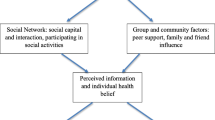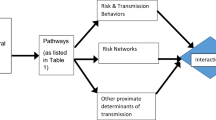Abstract
The Indian HIV epidemic is exhibiting a declining trend, providing an opportunity for meta-analysis and data synthesis by triangulation to delineate the comprehensive picture and to understand the drivers of the epidemic. A proximate determinants (PD) framework is used to tease out factors affecting HIV vulnerability and to segregate the interplay of multiple factors operating within the framework. This study focuses on low-risk general males and high-risk male clients who form bridges between high-risk and low-risk populations. Data from NFHS-III, IBBA-1 and BSS have been used. The findings underscore multi-partner, condom use and partner-mixing as PD for general men, with coital frequency an additional determinant for clients. Partner type and number of lifetime partners are significant determinants for both groups. Significant underlying determinants, after adjustment for PDs, are younger age, marital status and alcohol for general men, and marital status, education, age at first intercourse and prior HIV testing for clients.

Similar content being viewed by others
References
Barnighausen, T., & Tanser, F. (2009). Rethinking the role of the local community in HIV epidemic spread in sub-Saharan Africa: A proximate-determinants approach. HIV Therapy, 3(5), 435–445.
Boerma, J. T. (2008). WHO reprints or correspondence. World Health Organization: Dept. of Measurement and Health Information Systems.
Boerma, J. T., & Weir, S. S. (2005). Integrating demographic and epidemiological approaches to research on HIV/AIDS: The proximate-determinants framework. Journal of Infectious Diseases, 191(1), 61–67.
Bongaarts, J. (1978). A framework for analyzing the proximate determinants of fertility. Population Development Review, 4(1), 105–132.
Campbell, C., Yodwa, M., & Brian, W. (1998). Gender as an obstacle to condom use. Agenda, 14(39), 50–57.
Chandrasekaran, P., Dallabetta, G., Loo, V., Rao, S., Gayle, H., & Alexande, A. (2006). Containing HIV/AIDS in India: The unfinished agenda. The Lancet Infectious Diseases, 6(8), 508–521.
FHI/UNAIDS. (1998). In Proceedings from the meeting the behavioural data collection needs of national HIV/AIDS and STD programmes. Joint impact/FHI/UNAIDS workshop: Report and conclusions.
Garnett, G. P. (2002). The geographical and temporal evolution of sexually transmitted disease epidemics. Sexually Transmitted Diseases, 78, 14–19.
Garnett, G. P. (2007). Theory is critical in understanding the risks of acquiring HIV. Sexually Transmitted Diseases, 34(10), 737–738.
ICMR, FHI. (2007). IBBA Round 1. National Interim Summary Report.
Jejeebhoy, S. J., Koenig, M. A., & Elias, C. (2003). Investigating reproductive tract infections and other gynaecological disorders a multidisciplinary research approach. NetLibrary I, 24.
Koopman, J. S. (1996). Emerging objectives and methods in epidemiology. American Journal of Public Health, 86(5), 630–632.
Koopman, J. S., & Lynch, J. W. (1999). Individual causal models and population system models in epidemiology. American Journal of Public Health, 89(8), 1170–1174.
Lescano, C. M., Vazquez, E. A., Brown, L. K., Litvin, E. B., & Pugatch, D. (2006). Condom use with “casual” and “main” partners: What’s in a name? Journal of Adolescent Health, 39(3), 443.e1–443.e7.
Madlala, S. L. (2002). Youth, HIV/AIDS and the importance of sexual culture and context. Social Dynamics: A Journal of African Studies, 28(1) 20–41.
Mondal, S. (2009). Knowledge, attitude and risk: A study of male clients of female sex workers in the wake of HIV/AIDS Epidemic in Mumbai. PhD thesis, International Institute for Population Sciences.
Mondal, S., Singh, S. K., & Sharma, N. (2009). Sexual behavior and practices: A study of male clients of female sex workers in Mumbai. Journal of Family Welfare, 55(2) 39–53.
Mosley, W. H., & Chen, L. C. (1984). An analytical framework for the study of child survival in developing countries. Population Development Review, 10, 25–45.
National AIDS Control Organisation. (2006). Behavioural Sentinel Surveillance report on general population. Government of India: Ministry of Health and Family Welfare.
National AIDS Control Organization. (2010a). http://www.nacoonline.org/NACO. Accessed on June 2010.
National AIDS Control Organization. (2010b). National AIDS Control Programme-III Policy Document. http://www.nacoonline.org/National_AIDS_Control_Program/. Accessed on June 2010.
Perkins, J., Khan, K., & Subramanian, S. V. (2009). Patterns and distribution of HIV among adult men and women in India. PlosONE, 4, e568.
Pilkington, C. J. (1994). Is safer sex necessary with a “safe” partner? Condom use and romantic feelings. Journal of Sex Research, 31, 203–210.
Ramakrishna, J., Karrot, M., Murthy, R. S., & Srinivas, R. (2000). Experiences of sexual coercion among street boys in Bangalore. Paper presented at the international conference on adolescent reproductive health: Evidence and programme implications for South Asia, Mumbai 2000.
Sacco, W. P., Rickman, R. L., Thompson, K., Levine, B., et al. (1993). Gender differences in AIDS-relevant condom attitudes and condom use. AIDS Education and Prevention, 5(4), 311–326.
Sarkar, N. (2008). Barriers to condom use. European Journal of Contraception and Reproductive Health Care, 3(2), 114.
Schensul, S. L., Mekki-Berrada, A., Nastasi, B., Saggurti, N., & Verma, R. K. (2006). Healing traditions and men’s sexual health in Mumbai, India: The realities of practiced medicine in urban poor communities. Social Science and Medicine, 62(11), 2774–2785.
Shafii, T., Stovel, K., & Holmes, K. (2007). Association between condom use at sexual debut and subsequent sexual trajectories: a longitudinal study using biomarkers. American Journal of Public Health, 97(6), 1090–1095.
Sheeran, P., Abraham, C., & Orbell, S. (1999). Psychosocial correlates of heterosexual condom use: A meta-analysis. Psychological Bulletin, 125(1), 90–132.
Singh, S. K., Mondal, S., & Sharma, N. (2010a). Understanding the world of clients an inquiry into their preference for sexual avenues, risk perception towards HIV and attitude towards sex work in Mumbai, India. Demography India, 41(1).
Singh, S. K., Schensul, J., Gupta, K., Berg, M., Lahiri, S., & Cromley, E. (2010b). Alcohol use, sexual health risks and HIV prevention among young men in low income communities in Mumbai, India. Hartford, CT: International Institute for Population Sciences, The Institute for Community Research.
Singh, S. K., et al. (2009). Determinants of alcohol use, risky sexual behaviour and sexual health problems among men in low income community of Mumbai, India. AIDS and Behaviour, 14, 48–60.
Verma, R. K., Sureendar, S., & Guruswamy, M. (1997). What do school children and teachers in rural Maharashtra think of AIDS and sex. Health Transition Review, 7, 481–486.
Zablotska, I., Gray, R., Serwadda, D., Nalugoda, F., Kigozi, G., Sewankambo, N., et al. (2006). Alcohol use before sex and HIV acquisition: A longitudinal study in Rakai, Uganda. AIDS, 20, 1191–1196.
Acknowledgments
We would like to thank the National AIDS Research Institute (NARI), India for providing us Integrated Biological and Behavioral Assessment (IBBA) data and International Institute for Population Sciences (IIPS) for National Family Health Survey-III data.
Author information
Authors and Affiliations
Corresponding author
Rights and permissions
About this article
Cite this article
Sharma, N., Singh, S.K. & Mondal, S. Understanding the Factors Affecting the HIV Epidemic in Maharashtra: Application of Proximate Determinants Framework. Sexuality & Culture 17, 540–567 (2013). https://doi.org/10.1007/s12119-012-9160-3
Published:
Issue Date:
DOI: https://doi.org/10.1007/s12119-012-9160-3




